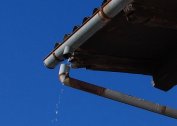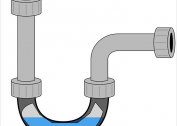Each time, starting repairs, we think about labor costs, materials and work performers. If the repair of a living room can be done by many of us, the question of how to change pipes in the bathroom and toilet often causes a lot of problems, since the standard layout of the bathrooms does not always meet the requirements and wishes of the owners of the house.
Pipe routing methods
 Piping in the toilet and bathroom can be done in two ways: open or closed.
Piping in the toilet and bathroom can be done in two ways: open or closed.
Open way - communications are outside. Advantages are constant access to communications, relatively easy access in the event of a malfunction or repair. The main disadvantage of this method is the aesthetic appearance, which can only be improved by placing pipes in close proximity to the floor.
Closed way - communications are hidden in the walls and floor. In this case, everything is in order with an aesthetic appearance, but maintenance of this type of water supply system is practically impossible, and a lot of difficulties will arise with ditching walls for pipelines.
Wiring diagrams
 There are three wiring diagrams:
There are three wiring diagrams:
- sequential;
- collector;
- with power sockets.
The latter option in everyday life is not used in practice due to its complexity and some specific features.
Serial wiring is simple, relatively low consumption of materials, fittings and drives, but provides an uneven distribution of water when several consumers are turned on at once.
Collector wiring allows for high maintainability of the system as a whole, since it provides for the installation of a tap for almost every consumer or group of consumers and ensures a more even distribution of water between consumers. The disadvantage is the bulkiness of the system, increased labor costs and difficulties in installation, as well as increased consumption of components and materials.
DIY pipe routing
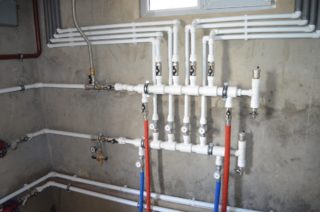 If you decide that you can do the wiring of water supply pipes with your own hands, then you can recommend plastic pipes, since they do not require any special skills or a specific tool.
If you decide that you can do the wiring of water supply pipes with your own hands, then you can recommend plastic pipes, since they do not require any special skills or a specific tool.
When wiring metal-plastic pipes with their own hands, it is necessary to ensure a minimum number of intersections of cold and hot water mains.
For the installation does not require the presence of specific materials and tools, it is necessary to prepare:
- hacksaw;
- file;
- roulette wheel;
- metal-plastic pipes;
- shaped elements;
- sealing cuffs;
- sealant
- 2 wrenches,
- plumbing thread.
Wiring of sewer pipes
 Wiring of sewer pipes in the bathroom and toilet is carried out with the obligatory observance of slopes of the mains, since the sewer system belongs to non-pressure systems, the movement of drains in which is carried out by gravity. The optimum slope for a pipe with a diameter of 50 mm is 3 cm per meter.
Wiring of sewer pipes in the bathroom and toilet is carried out with the obligatory observance of slopes of the mains, since the sewer system belongs to non-pressure systems, the movement of drains in which is carried out by gravity. The optimum slope for a pipe with a diameter of 50 mm is 3 cm per meter.
The preparation of straight pipe sections is carried out by cutting the required length. The pipes are cut with a hacksaw for metal, then you need to file a bevel at an angle of 15 degrees, which will prevent damage to the sealing sleeve. It is strictly forbidden to reduce the length of shaped parts (angles, tees and others). Before assembly, it is necessary to lay out all the elements on the floor in the places of their laying. In order to reduce internal stresses at the joints, the mating elements must be lubricated with silicone sealant.
Features of external wiring
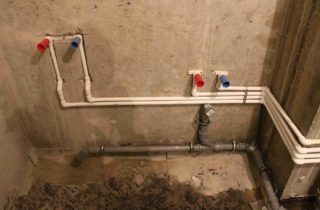 External wiring is used in those rooms where there is no way to hide pipes in the walls and ceiling blocks. Fix the sewer pipes using clamps that attach to the wall. In order to determine the distance between the holders, a simple rule is used: the distance between the holders should be no more than 10 pipe diameters. Thus, if the pipe diameter is 50 mm, then the holders must be placed every 50 centimeters.
External wiring is used in those rooms where there is no way to hide pipes in the walls and ceiling blocks. Fix the sewer pipes using clamps that attach to the wall. In order to determine the distance between the holders, a simple rule is used: the distance between the holders should be no more than 10 pipe diameters. Thus, if the pipe diameter is 50 mm, then the holders must be placed every 50 centimeters.
There are two schemes for fixing pipes - rigid and floating. The rigid scheme is suitable for rooms with a small area, metal or plastic clamps with a rubber seal are used for fastening, holders without a rubber seal are used for the second fastening option.
The installation technology of a closed system is the same as for an open system, it is necessary to observe slopes, to perform compensating gaps. When laying pipes in a gate, the gating of the walls must be carried out taking into account the required slopes, and the fastening of the system must be rigid and exclude its movement.
Water distribution routing
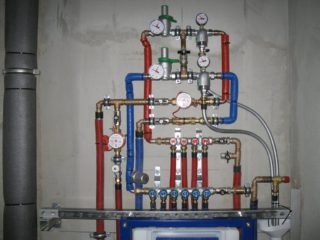 It is necessary to begin installation of the water supply system with the installation of emergency ball valves, which are located on the riser and shut off the water supply. The requirements for the emergency crane are quite high, it must withstand temperatures up to 150 degrees, and also have a working pressure of about 60 atmospheres.
It is necessary to begin installation of the water supply system with the installation of emergency ball valves, which are located on the riser and shut off the water supply. The requirements for the emergency crane are quite high, it must withstand temperatures up to 150 degrees, and also have a working pressure of about 60 atmospheres.
In order to increase the service life of the devices, filters should be installed that will prevent the ingress of foreign particles.
Separately, hot and cold water reducers and counters must be installed on the hot and cold water branch.
Collectors are installed on the branches of the cold and hot pipeline.
We install water sockets on the taps for bathtubs, sinks and for the washing machine, start up water pipes, the joints of which are connected by compression fittings. To do this, a tightening nut and a compression ring are put on the pipe, and the fitting end is inserted into the pipe. Seal the thread of the fitting with plumbing thread, then tighten the nut with the two wrenches to the stop.
Correct piping in the bathroom and toilet is achieved by thinking through all the risks and operating characteristics of a particular material. Do not save on shut-off and control devices. Locking screws or taps will shut off the water supply in the event of an accident or need. It is desirable that each consumer has its own tap, which will allow not to shut off the water supply to the entire apartment for repairs, cleaning or replacement.
In general, replacing pipes in the bathroom is a rather laborious and complicated process, but we can do it ourselves. It should be extremely careful and consistent. When you finish installing the pipes in the bathroom, you will need to check the system as a whole. To do this, connect all consumers or shut off the outputs to them with temporary plugs and supply water. If no leaks or leaks are detected during the day, then the water supply can be safely insulated and closed.
